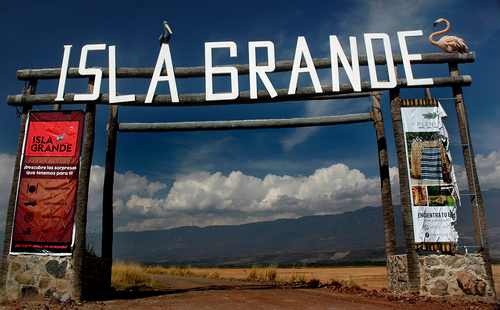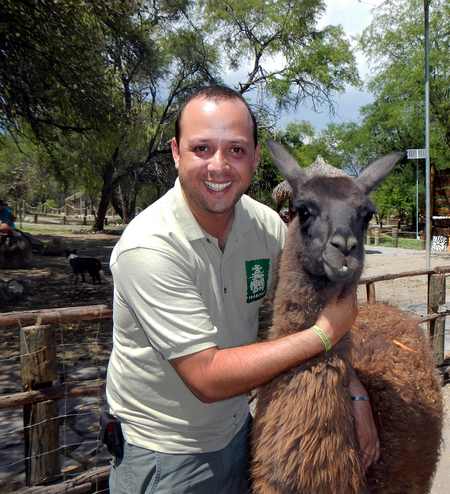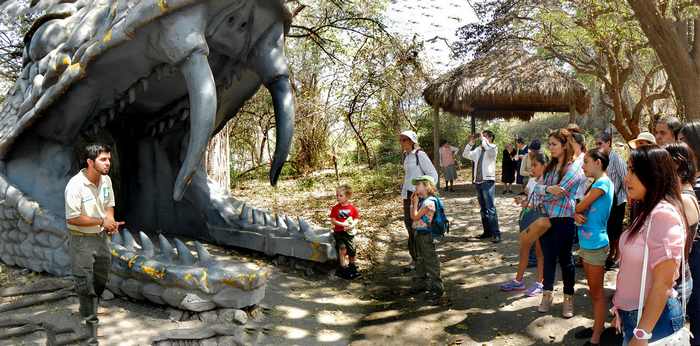|
By John Pint
 Chatting with some environmentalists, we heard about an animal reserve
called Isla Grande, located in the last place you'd expect to find a
park: right in the middle of the salt flats of Sayula, 70 kilometers
south of Guadalajara, Mexico. “They´ve created a sort of little Africa
out there,” said our informants, “and you can pet the animals.”
Chatting with some environmentalists, we heard about an animal reserve
called Isla Grande, located in the last place you'd expect to find a
park: right in the middle of the salt flats of Sayula, 70 kilometers
south of Guadalajara, Mexico. “They´ve created a sort of little Africa
out there,” said our informants, “and you can pet the animals.”
Well, we have some friends whose children dearly love animals, so we
invited them along and one Sunday morning headed for the town closest
to Isla Grande: Atoyac, a town located along toll road 54 between
Guadalajara and Colima.
We left Guadalajara at 9:00 AM, aiming to reach the reserve around
10:00 when it opens. This worked out fine and along the way we paid
only one toll of 129 pesos. Exactly where to go after leaving the
expressway was not very clear on the park's website (islagrande.com.mx)
but I figured we would just drive into Atoyac and find our way using
“Mexnet,” which, of course, you access by simply sticking your head out
the window of your car and asking directions.
No need. The Atoyac exit from the cuota road led us directly to a big
glorieta (roundabout) next to which there was a huge arch framing the
road to Isla Grande. Beyond the sign, there was a dirt road suitable
for all vehicles, in what I would call “good” condition, but what
others might describe as “tolerable,” heading right off into the middle
of what looked like a huge, flat desert.
“Africa, here we come—I hope!” shouted our driver Susy, and off we went.
The road is 2.7 kilometers long with no turnoffs. By Jorge, it actually
did lead us straight to a genuine island, green and wooded, right in
the middle of what had once been a shallow lake. We came to the
entrance of Isla Grande, where our license number was jotted down.
Inside there was parking space galore and a reception area where we
could pet llamas, sheep and a dwarf goat named Panchón who had free run
of the place. We were advised to visit the restrooms here because the
first stage of our safari would last about an hour.
Next we took seats in a shaded, flatbed camión, open on all sides. The
guide for our tour was Gilberto, who, I discovered, was an experienced
veterinario médico, not just hired help. I told him I was planning to
write an article on the park.
“Oh yes, I heard about you,” he said. “You're the man from National
Geographic, right?” And before I could reply to that, he had me sitting
with him in front on a little platform above the cab, with my feet
dangling over the side, so I could “get good pictures of the animals.”
With about 20 people on board, our vehicle lumbered through the first
of several locked gates into a very African-looking scenario of acacia
trees—which, of course, are known as huizaches here in
Mexico. Immediately several big llamas trotted up to check us out. Next
appeared an Eland who had been given the pet name “El Guapo,”
long-horned Ankole Watusis, ostriches (we learned to distinguish their
sex) and a huge but truly endearing Dromedary camel they called Emilio
which immediately fell in love with my big, heavy Nikon camera, on
which it bestowed several juicy kisses.
Gilberto had brought along lots of carrots we could feed to the
animals, but to get your hands on them, you had to answer one of his
many questions, all of them designed to educate us about nature. For
example, he said: “There's a tree within sight of us which grows
downward instead of upward. Anyone know which one it is?” We soon
discovered he was referring to the amate tree (strangler fig) right
next to us, which starts out as a seed dropped by a bird onto a tree
branch or a tall rock. It then produces a long, thin root, sometimes
many meters long, which eventually reaches the ground.
We soon came to a small lake where three hippopotami were blissfully
wallowing. After casually mentioning that more Africans are killed by
hippos than by any other animal, Gilberto invited me (only) to help him
toss carrots into these big animals' gaping mouths. I figured he wanted
to be sure a last photo of him would appear in Natgeo, just in case we
didn't survive the experience. Well, the hippos turned out to be about
as tame as teddy bears and for the first time in my life I got to
scratch one on the head. “Don't worry, all the animals we have here
were born in Mexico, in captivity, and are very friendly, except for
some of the snakes we are going to see now in the Herpetarium,” said
Gilberto. As we continued our drive, we were visited by buffaloes,
Nilgai antelopes, a Sika Deer named Elio and a Red Deer called Rogelia.
We walked into the Herpetarium through a giant snakes head, viewed some
deadly serpents (all behind glass) and enjoyed a wonderful show where
we met, up close, tarantulas, giant toads, baby crocodiles, an African
Spurred Tortoise called La Vaca for some reason, and a boa
constrictor which it took six people to hold horizontally. It was hard
to believe the staff members on stage were all professional
veterinarians because they put on a great show.
 Our safari took about two and a half hours. Upon our return to the
reception area, we were met by Omar Bárcena, Director of Wildlife
Projects. He, too, is a veterinarian who found his vocation when he
fell in love with animals as a child. Later in life he came to the
conclusion that what will help animals most is educating human beings
to respect them and to learn from them. He told us that Isla Grande has
been operating for just over a year, and its main focus is on
“environmental education while having fun.” It's not part of some
chain, but is autonomous and “unique.” At present the reserve has 120
animals representing 50 species. “Actually, we have 121 now,” he said,
“because a baby Watusi was born here recently.”
Our safari took about two and a half hours. Upon our return to the
reception area, we were met by Omar Bárcena, Director of Wildlife
Projects. He, too, is a veterinarian who found his vocation when he
fell in love with animals as a child. Later in life he came to the
conclusion that what will help animals most is educating human beings
to respect them and to learn from them. He told us that Isla Grande has
been operating for just over a year, and its main focus is on
“environmental education while having fun.” It's not part of some
chain, but is autonomous and “unique.” At present the reserve has 120
animals representing 50 species. “Actually, we have 121 now,” he said,
“because a baby Watusi was born here recently.” Bárcena says
the park will soon have its own restaurant, featuring regional dishes.
They'll also be adding to their repertoire a new show featuring
predatory birds, which will include eagles, kites, falcons, owls, crows
and vultures. “The star,” says Bárcena proudly, “will be Mexico's
national bird, the Golden Eagle, which weighs six kilos and has a
wingspan of two meters...but you won't see these birds in cages; you'll
see them in the air, hunting, and flying free.”
If you'd like to
get up close to animals you won't find in the pet shop, head for Isla
Grande, which is open on weekends and holidays from 10 AM to 6 PM. The
last safari camión leaves at 4:30 PM. Adults pay 150 pesos, kids 90
pesos and Golden-Agers get a 50% discount.
How
to get there
Take
toll road 54 south from Guadalajara, heading for Colima. Watch for the
Atoyac exit and
then follow the signs for Atoyac. You'll go straight to a big
roundabout (N20.01729 W103.53594) where you'll see a large arch
indicating the road to Isla Grande. Go straight southwest 2.7
kilometers to the reserve entrance (N20.00180 W103.55529). Driving time
from Guadalajara is about one hour and 15 minutes.

|

